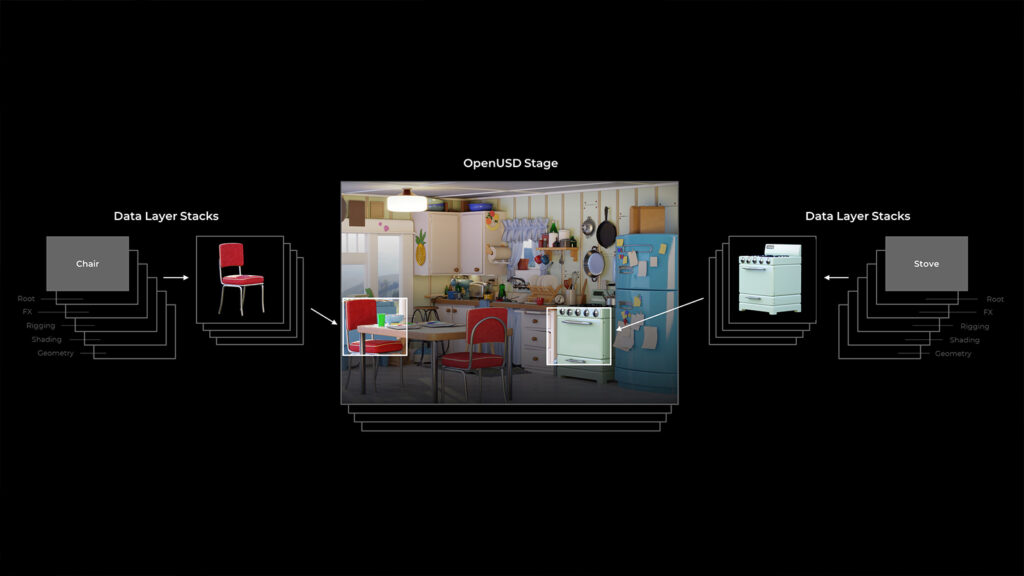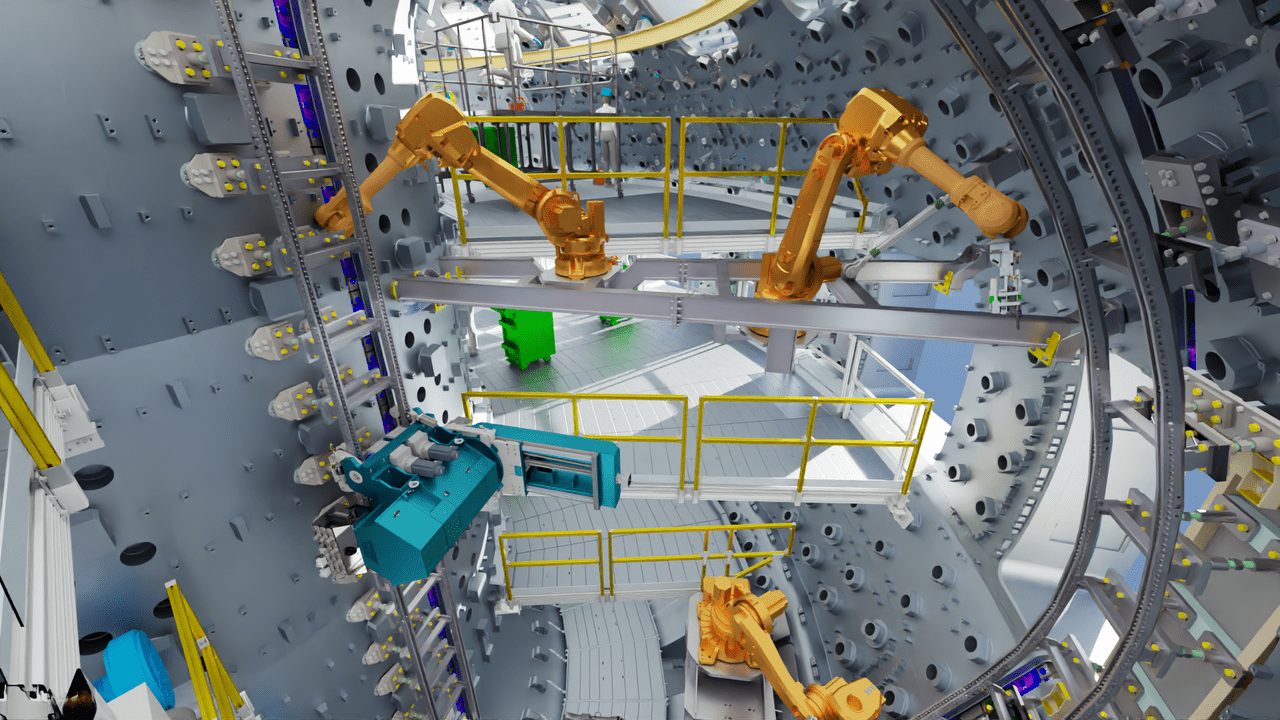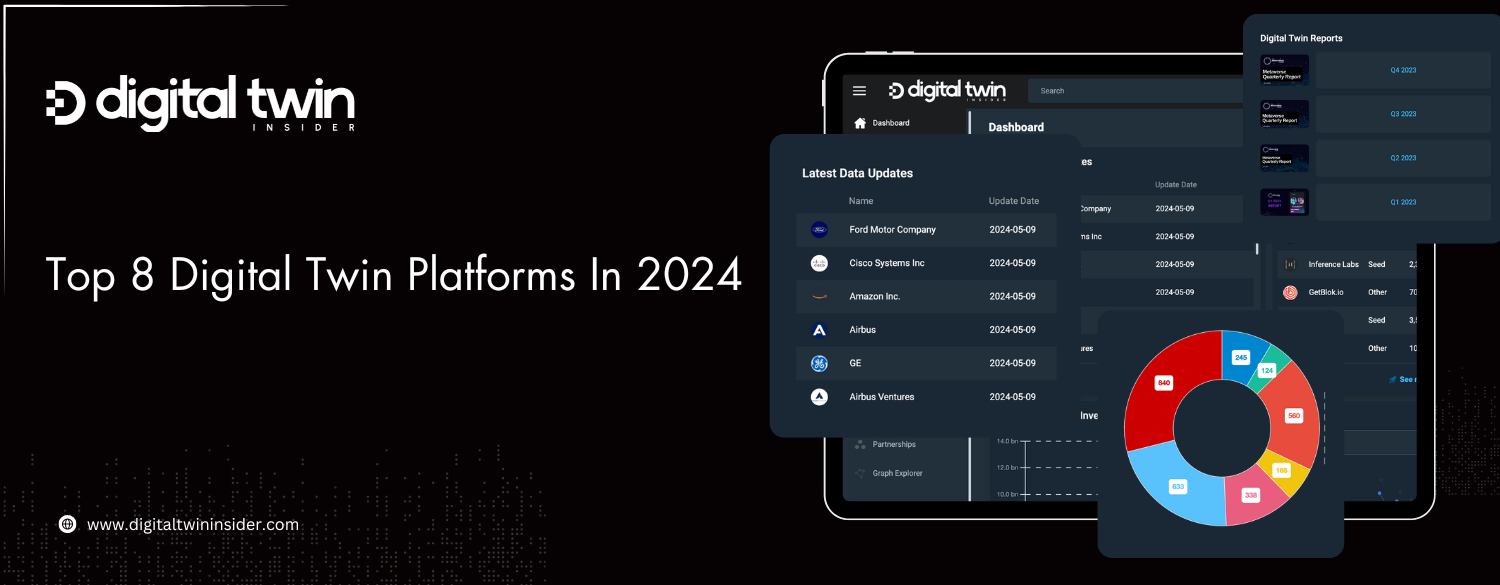Introduction
Digital Twin providers have developed numerous platforms to assist in creating digital twins. Operating mostly as PaaS, these platforms incorporate various software to build twins and are geared toward end users who want to develop digital twins. This article will shed light on the top digital twin platforms in 2024, providing insights into how these platforms build twins and what customers use them.
What Are Digital Twin Platforms?
Digital twin platforms are online services that enable companies and end users to build comprehensive digital twins replicas. These services offer advanced development tools for creating 3D assets in real-time, allowing the simulation of physical counterparts that process data instantaneously. These platforms also integrate the API of other software providers, ensuring a comprehensive platform that can digitally replicate real-world entities.
As highlighted in a previous article defining what we mean by a digital twin, these platforms have to be able to simulate 1-1 replicas of physical counterparts that access and feed data in real time and have realistic physics. Thus, these digital twin services must be considerably powerful.

The Key Difference Between Digital Twin Platforms and Companies
Digital Twin platforms and providers/companies are not a whole lot different. Providers such as NVIDIA have developed digital twin platforms such as NVIDIA Omniverse to offer clients the capability to build digital twins. However, not all companies in the digital twin space have built their own platforms. Examples of this include Bosch, that are developing twins for customers but does not have platforms themselves.
Similarly, companies and enterprises act as end users for providers who have built twin platforms. These companies purchase digital twin software services to give them the tools they need to develop their own virtual twin.
The next section of this article will outline the top 8 digital twin platforms you must look out for in 2024 as an end user.
8 Digital Twin Platforms To Look For In 2024
1. NVIDIA Omniverse
NVIDIA, founded in 1993 and headquartered in Santa Clara, California, is one of the most prominent technology companies. In 2024, it had over 26,000 employees worldwide and a revenue of $60 billion.
Perhaps the most well-known platform on this list, NVIDIA Omniverse, is a must-have for end users wanting to develop advanced and sophisticated digital twins. Launched in 2021, Omniverse enables users to create 3D workflows in real time using Universal Scene Description (USD) and advanced AI. The platform allows for the creation of digital twins in one comprehensive platform.
Because Omniverse uses USD, the platform strives for interoperability, enabling customers to integrate software and assets from other platforms. An example is integration with Bentley’s platform known as iTwin, using their software Lumen RT to create more immersive and realistic digital twins. Firm Brigantium Engineering was one of the first adopters of Lumen RT using the Omniverse platform, creating a 4D communication tool to improve workflows and efficiency.
This digital twin platform also integrates with numerous other software suppliers, such as Siemens and Cesium, to create the ultimate 3D development tool. Furthermore, due to developer-friendly SDKs, creating 3d assets on the platform that are freely customizable with no code options available is easy. Asset creation is also supercharged with generative AI integration and RTX computing.
Due to the platform’s scalability because of USD, NVIDIA plans to build a digital twin of the Earth known as Earth-2 for use cases such as predicting weather patterns, which is a considerable challenge for the company but one it is confident it can meet.

2. EcoStruxure Machine Expert Twin
Founded in 1836, Schneider Electric is one of the oldest companies on this list. It is headquartered in France, has around 155,000 employees, and generated 35.9 billion in revenue in 2023. Despite the digital automation companies’ age, Schneider Electric is by no means archaic. Schneider Electric operates a digital twin platform known as EcoStruxure Machine Expert Twin.
This unique platform is used by manufacturing OEMs globally to create digital twins of their manufacturing machines. EcoStruxure allows OEMs to develop machines virtually before being built to optimize and test them.
The platform has found considerable success with customers, such as ACMA, reporting significant go-to-market time, commissioning, and productivity improvements. EcoStruxure Machine Expert Twin is a leader in machine digital twinning with integration with top-tier manufacturing hardware such as the MC12 Multi-Carrier System.
3. Bentley Systems iTwin
As mentioned earlier, Bentley Systems iTwin is another platform widely used by companies to build digital twins. iTwin is built upon open APIs and digital twin software; the platform enables companies to create digital twins and SaaS solutions.
The platform also gives customers access to large datasets and ownership over their digital twins. iTwin is one of the leading digital twin platforms on the market, managing data flows, security, and overall maintenance of customers’ digital twins. As a result, Bentley Systems iTwin has been popular amongst clients like Allvision IO and SmartViz, who use the service to build digital twins of buildings and infrastructure.

4. Dassault Systemes 3DEXPERIENCE (3DX) Platform
Headquartered in France and founded in 1981, the company is one of the largest software providers in Europe, with over 22,000 staff. Dassault Systemes’s 3D EXPERIENCE platform is a cloud-based service that captures organizations’ workflows in 3D. 3DX enables customers to develop digital twins and integrate them with operational data, such as sensory data, in the real world.
The digital twins created by this platform live in real-time and are products of data input and output, undergoing consistent development. Companies such as Jaguar Land Rover are some of the major end-users using this platform to simulate their workflows through building technology such as digital twins.
5. AVEVA
Although AVEVA does not have a digital twin creation platform per se, it is worth a special mention on this list. AVEVA has developed several digital twin-enabling solutions, such as a platform known as CONNECT. CONNECT allows end users to link with relevant stakeholders in the industry that provide digital twin solutions and software. The platform enables users to manage data across a project’s lifecycle.
A new subsidiary of Schneider Electric, AVEVA, brings together leading providers, software, and end users through its platform. AVEVA is currently based in the United Kingdom and has around 6500 employees after being founded in 1967 in Cambridge.

6. Ansys Twin Builder
Formed in 1970 in Pennsylvania, Ansys is a prominent provider of digital twin software and has its own platform, the Ansys Twin Builder. Like the other platforms on this list, Ansys Twin Builder enables users to build digital twins and scale them post-deployment.
It can simulate industrial workflows, vehicle powertrains, and battery management systems. Prominent case studies include motorcycle manufacturer KTM’s use of the platform to manage its batteries and Wärtsilä’s use of the service to model complex battery systems.
7. Microsoft Azure Digital Twins
Technology giant Microsoft has also developed its own digital twin platform, Azure Digital Twins. This PaaS leverages the latest Azure technology to deliver an easily accessible and widely used digital twin platform with just one modeling code and a live execution environment to simulate comprehensive digital twins and track them over time.
The platform also integrates with the wider Azure Data analytics program to further enhance the development of digital twins. Microsoft is leading the way in the development of digital twins. The well-known company has over 220,000 employees after being founded by Bill Gates and Paul Allen in 1975.
8. PTC ThingWorx
The final company on this list is PTC and its ThingWorx platform. ThingWorx is a low-code, user-friendly platform that enables users with limited coding knowledge to develop a digital twin. Named an IoT industrial platform, ThingWorx allows users to build industrial-grade IOT solutions, removing barriers to adoption. The platform offers end-to-end solutions for developing digital twins.
It is a breath of fresh air for those wanting an easier time creating a twin without installing multiple external APIs. PTC was founded in 1985 and has around 7200 employees.
The Future Of Digital Twins Platforms and Software Solutions
The future of digital twin platforms is bright. Every day, more and more end users utilize the digital twin platforms mentioned in this article to build replicas of their physical assets. The providers in this article are some of the world’s leading software providers, all bullish on the future of digital twins in shaping sectors globally.
It is no coincidence that NVIDIA, one of the globe’s most profitable companies, is adamant that digital twins are the future, even pushing its limits by creating a digital twin of the Earth.
At the Digital Twin Insider, the digital twin market continues to grow at breakneck speed in line with the numerous use cases that companies, education providers, and general stakeholders are developing using this technology.
From 1-1 virtually simulated digital twin hearts that provide data in real-time to the creation of electrical grids virtually, digital twins are the future, with use cases driving the industry forward. The use cases are endless, and so is the market potential.
Why Might Businesses Be Interested In Using Digital Twin Platforms?
Businesses are always looking to reduce costs and improve the efficiency of their outputs. Digital twin platforms enable companies to do just that, allowing them to make decisions virtually in real time that immediately impact physical counterpart operations.
Due to the utility of instant optimization and risk testing, case studies have shown that digital twins dramatically increase a business’s efficiency, reducing costs and improving outputs.
Digital twins also enable businesses to create a digital twin of an entity, such as a factory, before it is even built, giving those companies the power to simulate scenarios before production. As a result, digital twin platforms are becoming an essential tool across industries for businesses wanting to improve the efficiency of their operations.

Conclusion
This article outlines the top digital twin platforms and why they are important. If you found the data interesting, check out our intelligence platform for further information on the ROI these platforms can generate for your business.
If you found this article to be informative, you can explore more current Digital Twin news here exclusives, interviews, and podcasts.













